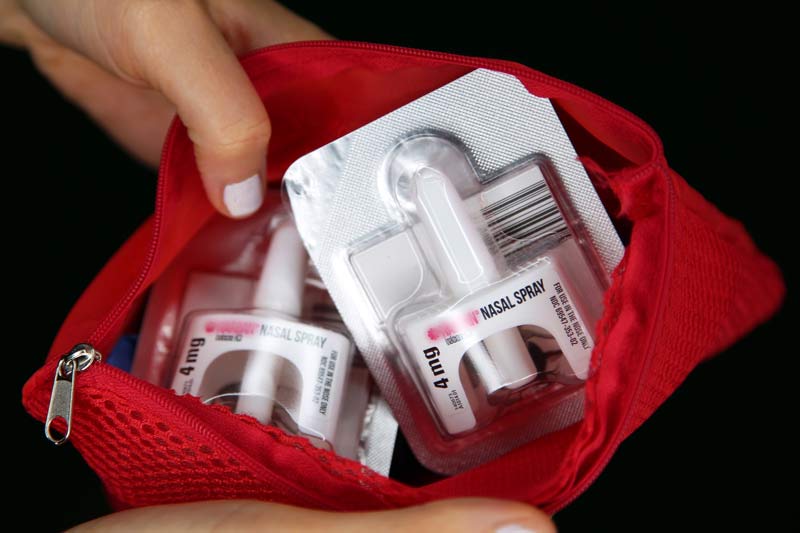On April 30, the Food and Drug Administration (FDA) approved a new, high-dose naloxone nasal spray. “Kloxxado,” manufactured by Hikma Pharmaceuticals, contains 8 mg of naloxone—twice the amount of the next-largest nasal dose currently available. Though intended to combat historic levels of opioid-involved overdose, drug safety experts are skeptical about how much this new device will actually help.
Naloxone is an antidote for opioid overdose. It works safely in overdoses involving heroin, prescription painkillers, fentanyl or other synthetic opioids. It’s available as an intramuscular shot, or as an intranasal spray. If administered promptly, naloxone can revive someone in minutes. Additional care, like rescue breathing, may be needed. The largest dose previously approved by the FDA was the 4 mg Narcan (brand name) nasal spray.
“Today’s action meets another critical need in combatting opioid overdose,” said FDA drug evaluation director Patrizia Cavazzoni in a statement. “Addressing the opioid crisis is a top priority for the FDA, and we will continue our efforts to increase access to naloxone and place this important medicine in the hands of those who need it most.”
But we already have 4 mg doses that can be administered one after another when necessary. Does this higher-dose naloxone give us a tool we don’t already have?
“Overdoses, even those involving fentanyl analogues, do not necessarily require multiple [or higher] doses of Narcan,” Dana Kurzer-Yashin, a strategist with the National Harm Reduction Coalition, told Filter. “When you hear about overdoses that require two, three or four doses of Narcan, this is likely because people are not waiting an adequate amount of time for the first dose to take effect.”
She described the proper way to use naloxone: Be patient. After giving the first dose to the person overdosing, administer rescue breathing and wait two to three minutes. Only then, if the person is still unresponsive, should you give a second dose. She acknowledged that this wait can feel terrifying, and that many people will rush to give additional doses out of fear.
“No one should be subjected to that type of excruciating pain if it is avoidable.”
Anti-drug misinformation about can lead us to actually make overdose more dangerous for the people who experience it. “This [new spray] may cause real damage by unnecessarily putting people in much more significant withdrawal than if they had received the 4 mg dosage,” Kurzer-Yashin said.
People with opioid use disorder who are thrown into sudden withdrawal by naloxone can be at high risk of overdosing again in the immediate aftermath—a danger that could be exacerbated by increasing the severity of the withdrawal through higher-dose naloxone.
“I have heard many participants talk about their experiences getting revived from an overdose by an EMT who gave them way more naloxone than was necessary,” Kurzer-Yashin said. “No one should be subjected to that type of excruciating pain if it is avoidable.”
She suggested that when possible, one should not use a nasal spray—which ejects all the medicine at once—but an injectable form which allows you to dispense only as much naloxone as is needed. Hikma Pharmaceuticals did not respond to Filter‘s request for comment by publication time.
Short of the political will needed to secure a safe supply, we have certain stopgaps to help keep people alive.
Sheila Vakharia, deputy director of the Department of Research and Academic Engagement for the Drug Policy Alliance, said that using higher-dose naloxone is not a sustainable way of reducing fatal overdose in the long run. Increasing evidence suggests that many people are purposely using opioids like fentanyl together with stimulants like cocaine or methamphetamine–which of course increases the risk of overdose.
In addition, Filter has reported on the phenomenon of street drug supplies throughout the US being transformed by an influx of fentanyl analogues in nearly everything from heroin to cocaine to methamphetamine. It is not often clear if all users are aware of the drug combinations they are taking.
“There’s only so much that high-dose naloxone can do to keep people alive in aggregate when the drug supply is unpredictable and there’s no sign of it becoming any safer,” Vakharia told Filter. “We need more than just high-dosage naloxone. We need safe supply to prevent these overdoses altogether, or at least drug-checking technology and safer consumption spaces.”
A truly safe supply of drugs would guarantee that a bag of heroin is just that—no unwanted fentanyl or anything else cut with it. This alone would drastically reduce overdose.
Short of the political will needed to secure a safe supply, we have certain stopgaps to help keep people alive. If we check drugs and tell people what’s in them, they can make an informed choice about what they’re putting in their bodies. And in safe consumption sites, people can use drugs away from the streets and police, with harm reductionists standing by to administer naloxone if needed.
The high-dose Kloxxado spray may prove attractive for emergency departments responding to overdose. But beyond that, it’s unclear in what specific circumstances it could be helpful, when using an additional 4 mg dose is also an option.
DPA previously provided a restricted grant to The Influence Foundation, which operates Filter, to support a Drug War Journalism Diversity Fellowship. Dr. Vakharia is a member of the board of directors of The Influence Foundation.
Photograph via National Institute on Drug Abuse




